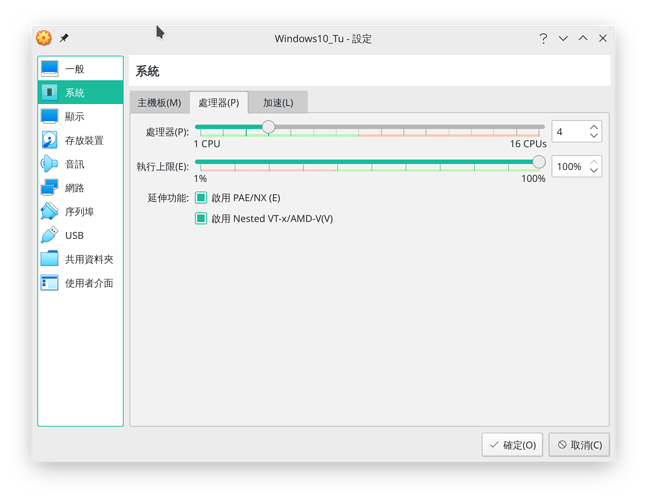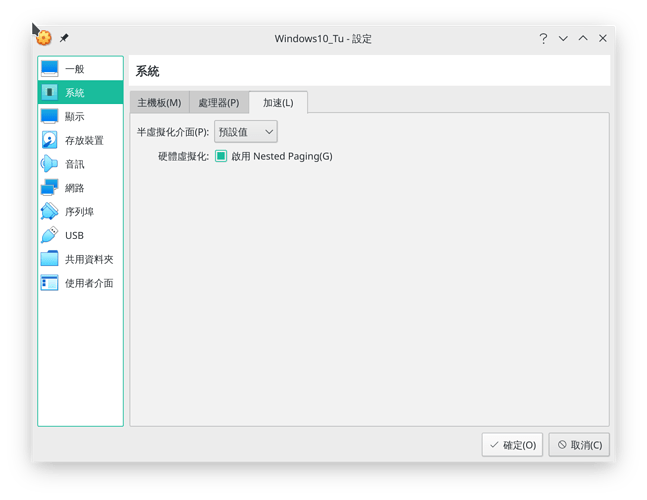Hi,
I’m actually not sure if the problem is caused by the CPU but it might be the major cause. Recently I just get back to my Manjaro desktop after more than one year due to the pandemic and would like to upgrade the hardware as well. I bought an AMD Ryzen 7 5800x and an MSI X570-A Pro to replace the original Intel i7-7740X and ASRock X299 Fatal1ty Gaming K6.
What I did is I replaced the hardware, and then used a Manjaro USB LiveMedia to boot the machine and then chroot to my original hardware to perform the full system upgrade. The reason I did this was that the kernel on the machine was an old version 4.19 and I heard somewhere that it doesn’t support 5th-gen Ryzen CPUs. In the meantime, I also shrank the swap partition and used the spared disk space to create an EFI system partition to convert the system from BIOS to EFI. After that, the system boots successfully and everything seems working fine. However, the Windows 10 guest VM for VirtualBox failed to boot now. It keeps entering to the blue screen of death, and every two fails it tries to enter repair mode but always enters a black screen. I tried to uncheck the AMD-v option, set the vCPU number to 1, etc, but none of the methods made it boot. I even created a new VM using the existing VM file (VDI) but still not successful.
I suspect the CPU difference cause the VM guest unusable?
Although I can simply create a new VM and get rid of the old one since it’s only for Microsoft Office and other Windows-specific software, I’m still curious about what makes the VM failed. Could someone please enlighten me on what might be the cause for such an issue?
Below is my system information:
System:
Kernel: 5.10.32-1-MANJARO x86_64 bits: 64 compiler: gcc v: 10.2.0
parameters: BOOT_IMAGE=/boot/vmlinuz-5.10-x86_64
root=UUID=aeb591b8-ee09-4b98-8b27-7b2be970592c rw amd_iommu=on
bootsplash.bootfile=bootsplash-themes/manjaro/bootsplash loglevel=3
rd.systemd.show_status=auto rd.udev.log-priority=3
resume=UUID=50d24d1e-4697-4c0a-a842-7ad88114aeab
Desktop: KDE Plasma 5.21.4 tk: Qt 5.15.2 wm: kwin_x11 vt: 2 dm: SDDM
Distro: Manjaro Linux base: Arch Linux
Machine:
Type: Desktop System: Micro-Star product: MS-7C37 v: 3.0 serial: <filter>
Mobo: Micro-Star model: X570-A PRO (MS-7C37) v: 3.0 serial: <filter>
UEFI: American Megatrends LLC. v: H.D4 date: 04/09/2021
Battery:
Device-1: hidpp_battery_0 model: Logitech Wireless Keyboard serial: <filter>
charge: 55% (should be ignored) rechargeable: yes status: Discharging
Device-2: hidpp_battery_1 model: Logitech Wireless Mouse serial: <filter>
charge: 55% (should be ignored) rechargeable: yes status: Discharging
CPU:
Info: 8-Core model: AMD Ryzen 7 5800X bits: 64 type: MT MCP arch: Zen 3
family: 19 (25) model-id: 21 (33) stepping: 0 microcode: A201009 cache:
L2: 4 MiB
flags: avx avx2 lm nx pae sse sse2 sse3 sse4_1 sse4_2 sse4a ssse3 svm
bogomips: 121602
Speed: 2873 MHz min/max: 2200/3800 MHz boost: enabled Core speeds (MHz):
1: 2873 2: 2879 3: 2874 4: 2880 5: 2878 6: 3598 7: 2878 8: 2875 9: 2878
10: 2880 11: 2874 12: 3599 13: 2879 14: 2879 15: 2877 16: 2879
Vulnerabilities: Type: itlb_multihit status: Not affected
Type: l1tf status: Not affected
Type: mds status: Not affected
Type: meltdown status: Not affected
Type: spec_store_bypass
mitigation: Speculative Store Bypass disabled via prctl and seccomp
Type: spectre_v1
mitigation: usercopy/swapgs barriers and __user pointer sanitization
Type: spectre_v2 mitigation: Full AMD retpoline, IBPB: conditional, IBRS_FW,
STIBP: always-on, RSB filling
Type: srbds status: Not affected
Type: tsx_async_abort status: Not affected
Graphics:
Device-1: NVIDIA TU104 [GeForce RTX 2080] vendor: Gigabyte driver: nvidia
v: 460.73.01 alternate: nouveau,nvidia_drm bus-ID: 2d:00.0
chip-ID: 10de:1e82 class-ID: 0300
Device-2: Logitech Webcam C930e type: USB driver: snd-usb-audio,uvcvideo
bus-ID: 1-1:2 chip-ID: 046d:0843 class-ID: 0102 serial: <filter>
Display: x11 server: X.Org 1.20.11 compositor: kwin_x11 driver:
loaded: nvidia display-ID: :0 screens: 1
Screen-1: 0 s-res: 3840x2160 s-dpi: 159 s-size: 613x352mm (24.1x13.9")
s-diag: 707mm (27.8")
Monitor-1: DP-0 res: 3840x2160 hz: 60 dpi: 161 size: 607x345mm (23.9x13.6")
diag: 698mm (27.5")
OpenGL: renderer: GeForce RTX 2080/PCIe/SSE2 v: 4.6.0 NVIDIA 460.73.01
direct render: Yes
Audio:
Device-1: NVIDIA TU104 HD Audio vendor: Gigabyte driver: snd_hda_intel
v: kernel bus-ID: 2d:00.1 chip-ID: 10de:10f8 class-ID: 0403
Device-2: AMD Starship/Matisse HD Audio vendor: Micro-Star MSI X570-A PRO
driver: snd_hda_intel v: kernel bus-ID: 2f:00.4 chip-ID: 1022:1487
class-ID: 0403
Device-3: Logitech Webcam C930e type: USB driver: snd-usb-audio,uvcvideo
bus-ID: 1-1:2 chip-ID: 046d:0843 class-ID: 0102 serial: <filter>
Sound Server-1: ALSA v: k5.10.32-1-MANJARO running: yes
Sound Server-2: JACK v: 0.125.0 running: no
Sound Server-3: PulseAudio v: 14.2 running: yes
Sound Server-4: PipeWire v: 0.3.26 running: yes
Network:
Device-1: Realtek RTL8111/8168/8411 PCI Express Gigabit Ethernet
vendor: Micro-Star MSI X570-A PRO driver: r8169 v: kernel port: d000
bus-ID: 27:00.0 chip-ID: 10ec:8168 class-ID: 0200
IF: enp39s0 state: up speed: 100 Mbps duplex: full mac: <filter>
Device-2: Edimax Edimax AC1750 USB type: USB driver: 8814au bus-ID: 7-4:2
chip-ID: 7392:a833 class-ID: 0000 serial: <filter>
IF: wlp47s0f3u4 state: down mac: <filter>
Drives:
Local Storage: total: 2.71 TiB used: 1.27 TiB (46.9%)
SMART Message: Unable to run smartctl. Root privileges required.
ID-1: /dev/sda maj-min: 8:0 vendor: Intel model: SSDSCKKW480H6
size: 447.13 GiB block-size: physical: 512 B logical: 512 B speed: 6.0 Gb/s
rotation: SSD serial: <filter> rev: 036C scheme: GPT
ID-2: /dev/sdb maj-min: 8:16 vendor: Samsung model: SSD 860 EVO 500GB
size: 465.76 GiB block-size: physical: 512 B logical: 512 B speed: 6.0 Gb/s
rotation: SSD serial: <filter> rev: 1B6Q scheme: GPT
ID-3: /dev/sdc maj-min: 8:32 vendor: Seagate model: ST2000DX002-2DV164
size: 1.82 TiB block-size: physical: 4096 B logical: 512 B speed: 6.0 Gb/s
rotation: 7200 rpm serial: <filter> rev: CC41 scheme: GPT
Partition:
ID-1: / raw-size: 431.03 GiB size: 423.26 GiB (98.20%)
used: 124.75 GiB (29.5%) fs: ext4 dev: /dev/sda1 maj-min: 8:1
ID-2: /boot/efi raw-size: 512 MiB size: 511 MiB (99.80%)
used: 152 KiB (0.0%) fs: vfat dev: /dev/sda3 maj-min: 8:3
ID-3: /home raw-size: 1.82 TiB size: 1.79 TiB (98.38%)
used: 858.76 GiB (46.9%) fs: ext4 dev: /dev/sdc1 maj-min: 8:33
ID-4: /opt raw-size: 465.76 GiB size: 457.45 GiB (98.22%)
used: 319.37 GiB (69.8%) fs: ext4 dev: /dev/sdb1 maj-min: 8:17
Swap:
Kernel: swappiness: 60 (default) cache-pressure: 100 (default)
ID-1: swap-1 type: partition size: 15.6 GiB used: 0 KiB (0.0%) priority: -2
dev: /dev/sda2 maj-min: 8:2
Sensors:
System Temperatures: cpu: 33.4 C mobo: 31.0 C gpu: nvidia temp: 44 C
Fan Speeds (RPM): fan-1: 1807 fan-2: 2347 fan-3: 850 fan-4: 582 fan-5: 0
fan-6: 0 fan-7: 0 gpu: nvidia fan: 0%
Info:
Processes: 335 Uptime: 46m wakeups: 33 Memory: 15.62 GiB
used: 3.74 GiB (23.9%) Init: systemd v: 247 tool: systemctl Compilers:
gcc: 10.2.0 Packages: pacman: 1615 lib: 381 flatpak: 0 Shell: Bash v: 5.1.0
running-in: konsole inxi: 3.3.04
Thanks in advance.


 .
.